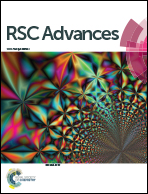High visible-light photochemical activity of titania decorated on single-wall carbon nanotube aerogels†
Abstract
Photocatalysts are being extensively investigated to convert renewable solar energy into chemical energy but suffer from high costs or low efficiencies. We report on the development of highly visible-light photoactive composites of titania (TiO2) and single-wall carbon nanotubes (SWCNTs) that rapidly photodegrade methylene blue dyes under visible-light illumination in the absence of cocatalysts. We fabricated these freestanding porous composites of density ≈36 mg mL−1 (volume fraction ≈ 0.01) by an in situ sol–gel synthesis of titania nanoparticles of diameter ≈9 nm within SWCNT aerogels. The SWCNT aerogels are three-dimensional porous networks of individualized SWCNTs having a density ≈9 mg mL−1 (volume fraction ≈ 0.006), whose large surface area and high porosity enable substantial titania loading and unimpeded dye transport to titania. The TiO2/SWCNT aerogel composites had a surface area of 293 m2 g−1 and pores of diameters between 2–25 nm. X-ray photoelectron spectroscopy showed a strong bonding interaction between titania and SWCNTs (i.e., titanium–carbon and titanium–oxygen–carbon bonds), which possibly rendered these aerogel composites photoactive in visible-light with an absorption edge ≈2.6 eV. In contrast, titania is only active in ultraviolet-light due to its large bandgap (≈3.2 eV). Further, they degraded dyes at a rate of ≈25 μmol g−1 h−1 with a rate constant of ≈0.012 min−1 under visible-light irradiation, values that are more than two times greater than those from other titania-based photocatalysts under visible or ultraviolet illumination. In comparison, titania nanoparticles alone were essentially inactive under similar test conditions. Interestingly, the rate constant for dye degradation decreased with an increase in dye concentration, but the overall rate of degradation remained nearly unchanged. Moreover, the addition of platinum cocatalysts did not improve the photocatalytic performance of the TiO2/SWCNT composites. These observations suggest that the composites efficiently separate visible-light generated electron–hole pairs and that photodegradation was limited by the availability of reactive sites on titania (the anodic reaction). We postulate that further enhancements are plausible through composite design and that our facile fabrication method can be readily adapted to create nearly any freestanding photocatalyst/SWCNT aerogel composites for use in high performance photoelectrochemical cells.



 Please wait while we load your content...
Please wait while we load your content...